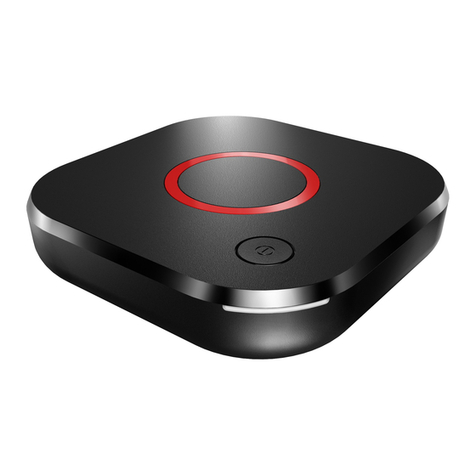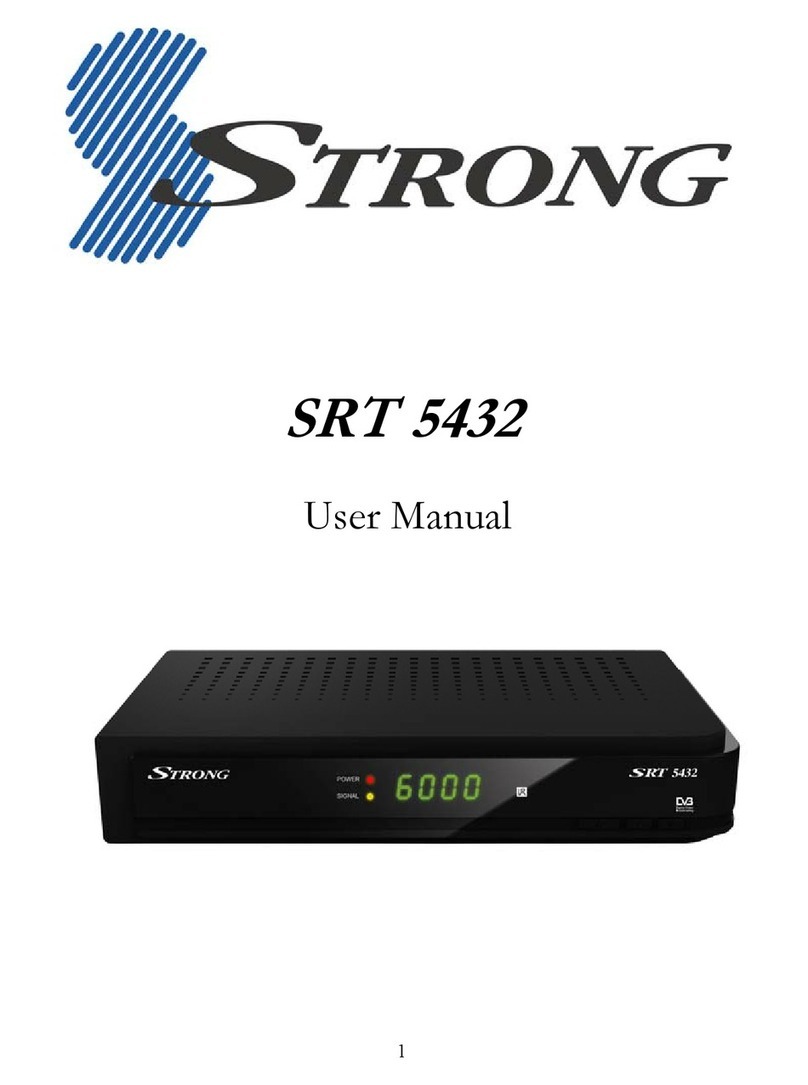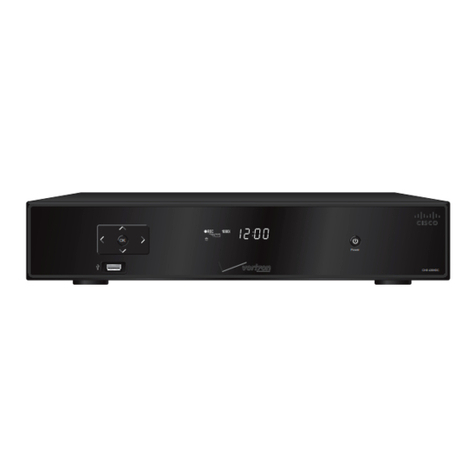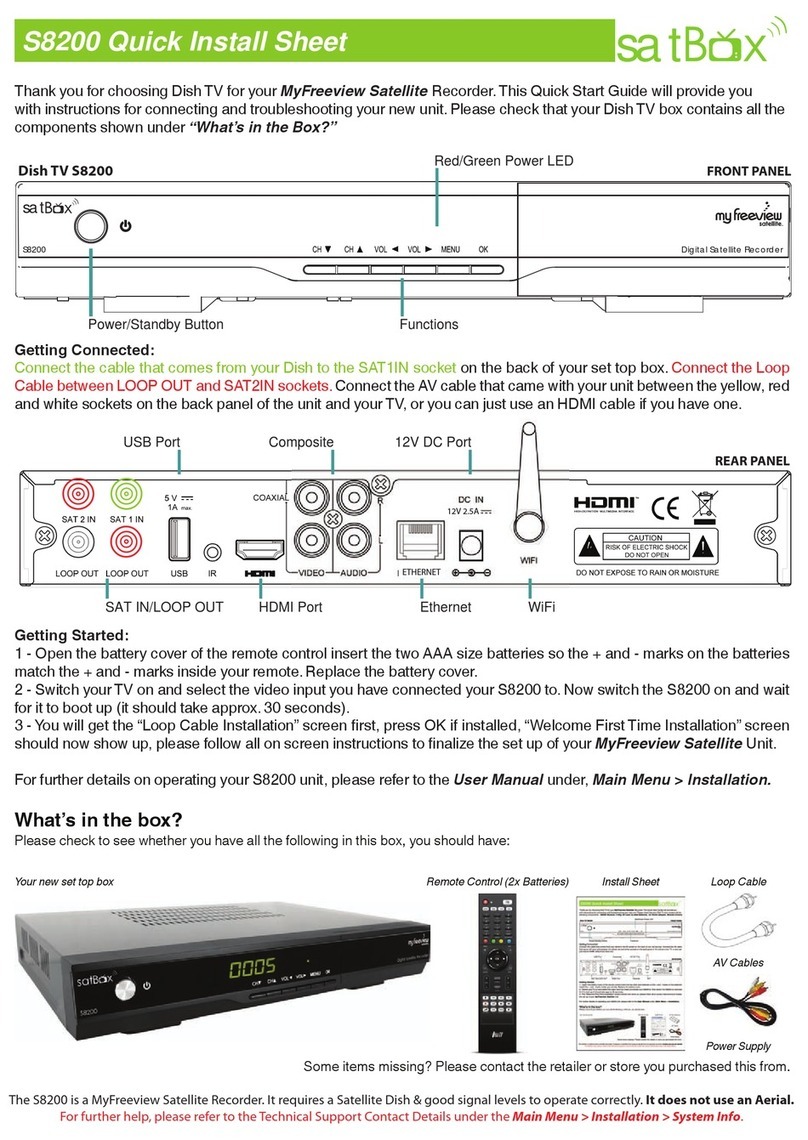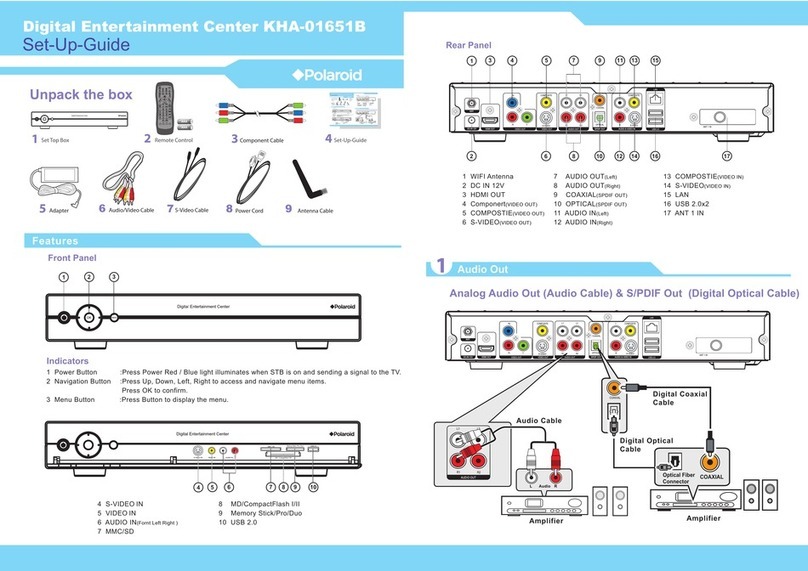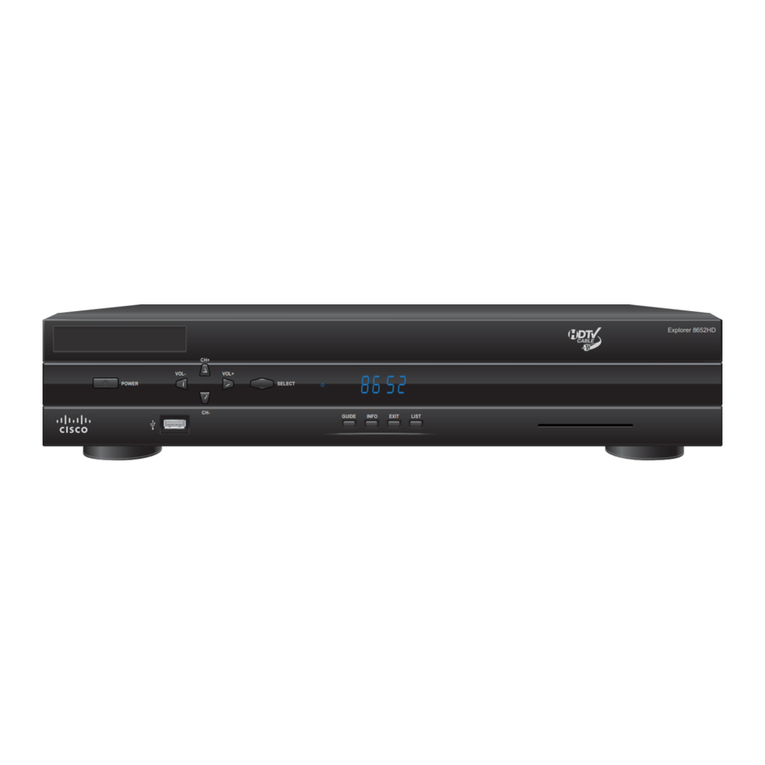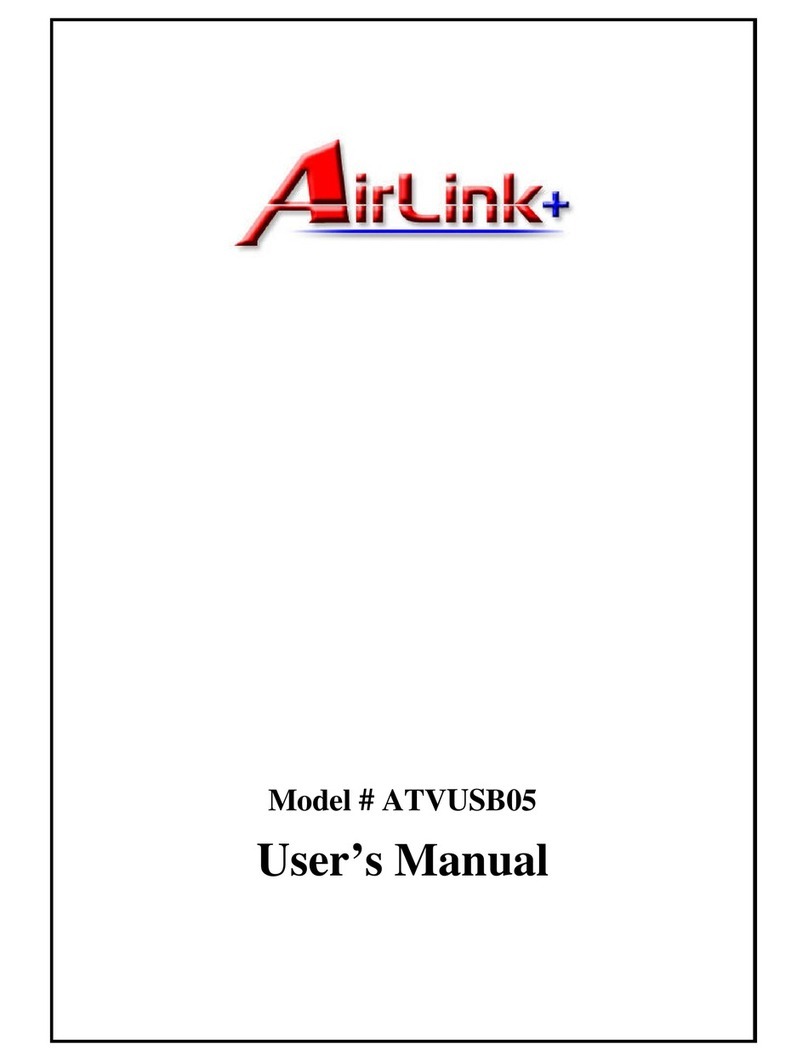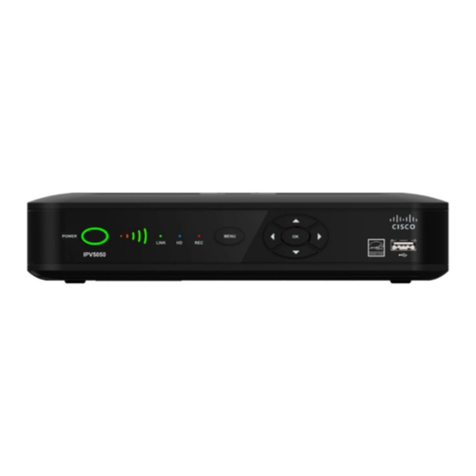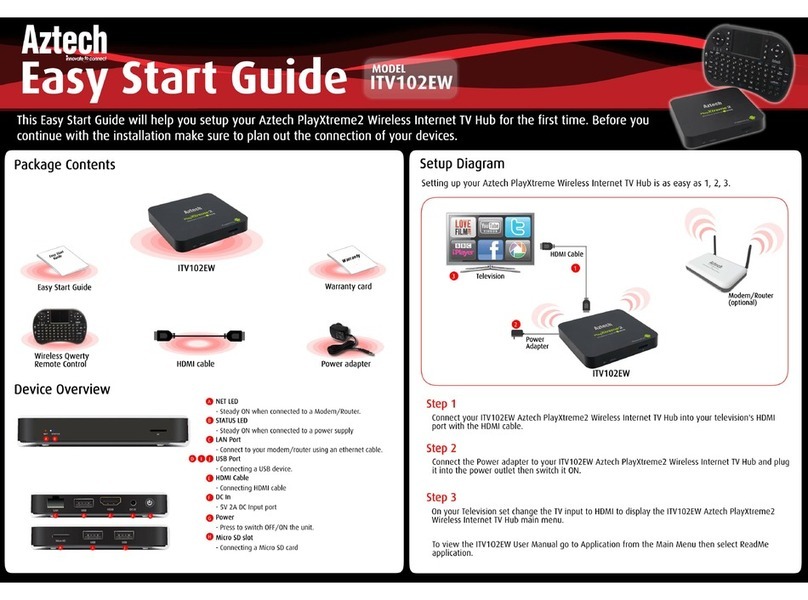Infomir MAG-200 Manual

IPTV MAG-200 High resolution device
Operator Guide
©Informir, 2009

MAG-200 Operator Guide Rev 1.05.
Contents
Definitions ...................................................................................................................4
Boot loader for the device ...........................................................................................4
Boot loader menu....................................................................................................4
Description of the menu.......................................................................................5
Bootloader upgrade.................................................................................................8
Setting operator key and logo. ................................................................................9
Preparation of the logo ........................................................................................9
Installation of the logo..........................................................................................9
Actions after the device is switched on..................................................................10
Basic program loading from “NAND” .................................................................11
Basic program loading from “DHCP” .................................................................11
Indication of basic program loading ...................................................................12
Bootstrap ..................................................................................................................13
Configuring and organizing the process of program upgrade using cyclic multicast
groups.......................................................................................................................16
Prepation of images for broadcast ........................................................................16
Preparation of Bootstrap....................................................................................17
Preparation of uImage, uImzlib_null.img, uImzlib.img........................................17
Preparation of imageupgrade ............................................................................17
Server DHCP setting.............................................................................................17
Cyclic multicast server configuration. ....................................................................18
Description of the process of program upgrade wiuth the use of cyclic multicast
groups ...................................................................................................................18
Work with keys..........................................................................................................20
Preparation of operator key...................................................................................20
Default operator key..............................................................................................21
Remarks concerning the work with gpg program ..................................................22
Variants of the device control....................................................................................23
Transfer and handling operator command using multicast group..........................23
Addition of operator commands.........................................................................23
Format of the file containing operator commands..............................................24
Configuring the sub-system of transferring and handling operator commands..24
Operator commands..........................................................................................24
Control from browser.............................................................................................25
Utilities description....................................................................................................26
Utility fw_printenv ..................................................................................................26
Utility fw_setenv ....................................................................................................26
Utility dsign............................................................................................................26
Utility mcsend........................................................................................................27
Utility mcrec...........................................................................................................29
Utility “Controlling indicator on front panel “ (setFpanel) .......................................29
Program lirc...........................................................................................................30
Handling the keys on the front panel.....................................................................31
2

MAG-200 Operator Guide Rev 1.05.
Re-start of the device with changing loading regime.............................................32
Supplements ................................................................................................................33
Location of sections innor-flash иnand-flash –memory............................................33
Connectors on the back panel ..................................................................................33
Description of vendor-specific options ......................................................................34
Example of the file dhcpd.conf..................................................................................35
Example of the file mcast.conf ..................................................................................37
3

MAG-200 Operator Guide Rev 1.05.
Definitions
Bootloader – Bootloader allows loading and starting the basic program.
Basic program – the complex of software and hardware, which allows rendering
services to the user.
Bootstrap – Specially prepared image for the basic program upgrade. It consists of the
Linux core and RAM root file system signed with a digital signature.
Core – Linux core.
Cyclic multicast group – multicast group with cyclic broadcast of data.
Bootloader of the device
The bootloader is used for loading and starting the basic program. The
bootloader allows loading the basic program from the network and from nand-flash with
further check of the loaded image integrity. The basic program can be loaded from the
network using tftp protocol or from the multicast group. The loading stages are
reflected on TV screen and on the front panel indicator. The bootloader menu can be
used to change the loading mode, to set logo and operator key.
After the device is switched on the bootloader sets the following modes of video
outputs:
•HDMI, Component ( YPrPb), SCART – 576p;
•CVBS, S-Video – 576i
Some menu items set the variables of the bootloader. Sometimes there may
arise the necessity to know the values of these variables. This can be achieved with
the help of the utility fw_printenv. For example, the command “fw_printenv tvsystem”
shows the current value of the variable tvsystem.
Bootloader menu
To enter the bootloader menu press and keep the key “menu” on the remote
control or the key “On/Off” on the front panel and switch on the device.
Navigation in the bootloader menu is ensured with remote control and front
panel keys. The keys Up/Down allow moving between the menu items. The key “to the
right” allows entering a menu item or changes the item value. The key “to the left”
provides exit to the previous menu or confirms the performance of the operation (“OK”).
4

MAG-200 Operator Guide Rev 1.05.
Menu description
TV System
It sets the mode of video outputs in the basic program. The basic program checks the
value set in this item and correspondingly initializes the video output.
This menu item sets the variable “tvsystem”. The following values are possible:
•PAL;
•576p-50;
•720p-50;
•1080i-50;
•NTSC;
•576p-60;
•720p-60;
•1080i-60;
Graphic Res.
Sets the resolution of graphic window for the basic program. The basic program checks
the value set in this item and sets the corresponding resolution for the graphic window
of the supplement. If the value of the resolution specified exceeds the value of
resolution of the video outputs, the most appropriate resolution shall be used. This item
of the menu sets the variable “graphicres”. The following values are possible:
•720x576;
•1280x720;
•1920x1080;
•TV System Res..
If the value of «TV System Res.» is set, the resolution corresponding to the current
mode of video outputs is used.
Соmponent out
Sets the mode of the component video output in the basic program, The basic program
checks the value set in this item and sets the mode of the component video output.
This menu item sets the variable “componentout”. The following values are possible:
•YPrPb;
•RGB.
5

MAG-200 Operator Guide Rev 1.05.
Boot Mode
Sets the mode of the basic program loading. The following values are possible.
•DHCP;
•NAND.
Device Info
Information of the device. The same information of the device and current IP can be
obtained by issuing the command “/usr/bin/info.sh”
Loader Info
Information on the bootloader version and date of creation. This information is sent by
the bootloader on dhcp request.
Image Info
Information on the image stored in nand-flash. This information is set by standard
bootstrap when upgrading the image.
Version
The image version on the device is a number. The version is set by the operator in the
process of forming the image. Standard bootstrap checks the version number on the
device and performs upgrade only if the image version number is higher than the one
installed or if the versions of images are the same and the value of item ““Forced” is set
to “Yes”.
In this way the protection against double upgrade and return to the previous version
image is realized.
This menu item sets the variable “Image_Version”
Date
The date of the image creation.
This menu item sets the variable “Image_Date”
Description
Short description of the image. It is set by the operator when creating the image.
This menu item sets the variable “Image_Desc”
Forced
6

MAG-200 Operator Guide Rev 1.05.
Possible values:
•Yes;
•No.
This menu item sets the variable “Ver_Forced”
Upgrade Tools
Use upgrade
If the value “Yes” is chosen, the second image of the bootloader is set and the digital
signature is checked; the second image shall be automatically started when the device
is switched on. If “No” is set, the manufacturer bootloader shall be started.
Possible values:
•Yes;
•No.
This menu item sets the variable “bootupgrade”.
Auto Upgrade
Starts the process of upgrading the second copy of the bootloader.
MC Upgrade
Starts the process of upgrading the basic program using fixed multicast addresses.
Set LOGO&KEY
Starts the process of setting and upgrading the logo and operator key.
Reset Op.KEY
Allows resetting the operator key. Generally accessible key stb_pub_sign.key. shall be
used as the key after reset.
Def. Settings
Reset of all bootloader variables. All variables of the loader are set to the manufacturer
values.
Exit & Save
Exit from the menu and save all changes made.
7

MAG-200 Operator Guide Rev 1.05.
Exit & Discard
Exit from the menu without saving the changes.
Booloader upgrade
The manufacturer installs the bootloader to the device but there is a possibility to
install another copy of the bootloader prepared by the manufacturer. The second copy
is stored in the section mtd2 nor- of the flash memory.
To install the second copy of the bootloader proceed as follows:
1. switch off the device;
2. press the key “menu” on the remote control;
3. switch on the device;
4. select the menu item “Upgrade Image”/“Auto Upgrade”;
5. wait till the operation is successfully finished;
6. set the item “Use upgrade” to “Yes”.
When performing item 4 the device forms a dhcp-request with the following
parameters:
1. vendor_class_id - "TeleTecMAG200upgboot"
2. dhcp_client_id - "TeleTecMAG200-XX:XX:XX:XX:XX:XX", where
XX:XX:XX:XX:XX:XX – MAC device address
3. The section vendor_spec contains the following options:
•Number of the bootloader version: Vernum – format line
"XXX" with leading zeroes
•Date and time: datetime - __DATE__" - " __TIME__
Indicate the location of the upgrading file in the answer. The dhcpd.conf: file
contents:
class "TeleTec MAG200 Upgrade"
{
match if (( option vendor-class-identifier="TeleTecMAG200upgboot"));
filename "mag200/Sboot";
next-server 192.168.1.1;
}
The line substring (option vendor-encapsulated-options,2,3) returns the version
of the bootloader.
8

MAG-200 Operator Guide Rev 1.05.
According to the protocol tftp the device loads the flash located on the route
filename ("mag200/Sboot") from the server specified in the next-server (192.168.1.1)
and performs upgrading.
If the option “Use upgrade” is set to “Yes”, it shall contain the following items
when entering the bootloader menu: “Upgrade Tools”, “Def. Settings”, “Exit & Save”,
“Exit & Discard”; they agree with the bootloader items. Additional item “Upgrade Menu”,
appears, which allows moving to the full menu of the bootloader
If the option “Use upgrade” is set to “No”, the manufacturer bootloader shall be
used.
Setting the operator key and logo
The device allows setting the logo in the process of loading. This logo appears
after switching on the device and before the basic program is started. Information
messages that reflect the process of the basic program loading are displayed on the
background of the logo.
Logo preparation
A file in the format bmp 8Bit, 16Bit 565RGB or 24Bit 888RGB can be used as a logo.
The file can be compressed with the archiver gzip:
gzip -S .gz ./STB-bootlogo.bmp
The size of the file to be installed in the device should not exceed 48Kb.
Logo installation
When the menu item “Upgrade Image”/ “Set LOGO&KEY” is chosen the device shall
form a dhcp-request with the following parameters:
1. vendor_class_id - " TeleTecMAG200upglogo"
2. dhcp_client_id - "TeleTecMAG200-XX:XX:XX:XX:XX:XX", where
XX:XX:XX:XX:XX:XX – MAC device address
Indicate the location of the upgrading file in the answer. The contents of the file
dhcpd.conf:
class "MAG200_upglogo" {
match if (( option vendor-class-identifier="TeleTecMAG200upglogo"));
filename "mag200/ STB-bootlogo.bmp.gz";
next-server 192.168.1.2;
9

MAG-200 Operator Guide Rev 1.05.
vendor-option-space TeleTec;
option TeleTec.logo_x 0;
option TeleTec.logo_y 0;
option TeleTec.bg_color 0x00006498;
option TeleTec.fg_color 0x00FFFFFF;
option TeleTec.oppubfile "mag200/op_stb_pub_sign.key";
}
According to the protocol tftp the device loads ("mag200/ STB-bootlogo.bmp.gz
") from the server specified in the next-server located on the route filename, performs
check, displays the logo on the screen and saves the logo.
Besides, it is possible to set the coordinates of the left upper corner of the logo.
These are dhcp options: TeleTec.logo_x – x axial coordinate, TeleTec.logo_y – y axial
coordinate. If these options are not specified or if they are reset, the picture shall be
automatically centered.
The options dhcp TeleTec. bg_color and TeleTec.fg_color allow specifying
correspondingly the colour of the background and the colour of the type in the format
“XRGB” for displaying information messages in the process of loading.
If the process was successfully completed, the variables of the bootloader
“logo_x”, “logo_y”, “bg_color”, “fg_color” are set to the corresponding values and the
variable “showlogo” is set to “yes”.
This process also sets the signed and prepared operator key. If the dhcp answer
has the option TeleTec.oppubfile set, the attempt to read from the server the indicated
file according to the protocol tftp is performed, and in case of success the bootloader
variable “oppubKEY” is assigned with the contents of the loaded file.
Hereinafter it shall be used as the operator key.
Steps after switching on the device
When the system is started, the bootloader analyses the loading mode set. If the mode
“NAND” is specified, the basic program is started from nand-flash, if “DHCP” is
specified, the start is performed using dhcp protocol.
10

MAG-200 Operator Guide Rev 1.05.
Basic program loading mode “NAND”
If the basic program loading mode is set to “NAND”, the bootloader attempts to
load the Linux core. The Linux core must be stored in the section mtd4, where the file
system jffs2 must be installed and it should be called uImage. After the core is loaded,
its digital signature is checked using the operator key installed. (The operator key must
be installed earlier; otherwise the accessible key stb_pubbin.key is used. In the image
prepared by the manufacturer the core is signed using this key). After checking the
core is started; in this case the section mdt5, where the file system jffs2 is to be
installed shall be specified as the root file system.
If an error occurs at any stage of loading, the device automatically transfers to
loading the basic program in the “DHCP” mode.
“DHCP” mode of the basic program loading
The device sends dhcp- request with the following parameters:
1. vendor_class_id - " TeleTecMAG200boot "
2. dhcp_client_id - "TeleTecMAG200-XX:XX:XX:XX:XX:XX", where
XX:XX:XX:XX:XX:XX – MAC device address
3. The section vendor_spec contains the following options:
a. Bootloader version number: Vernum – a line in the format "XXX" with
leading zeroes
b. Date and time: datetime - __DATE__" - " __TIME__
Having received the dhcp-answer the bootloader analyses the presence of
options TeleTec.mcip and TeleTec.mcport. If they are present the bootloader connects
to the multicast group specified by these parameters and accepts the image from this
group. If these options are not specified the image is loaded according to the protocol
tftp from the server next-server located on the route filename ("mag200/Bootstrap") .
Thereafter the digital signature of the loaded image is checked using the
installed operator key. After the check the image is started specifying the nfs section
situated at the address specified in the option “root-path” as the root file system (the IP
of the server should be specified in the beginning of this parameter followed by a colon
and the location of the catalogue to be assembled as the root of the file system). The
boostrap ignores the option “rootp-path”.
The contents of the file dhcpd.conf:
11

MAG-200 Operator Guide Rev 1.05.
•To load Bootstrap from multicast group 224.10.0.50:9000:
class "MAG200_boot" {
match if (( option vendor-class-identifier="TeleTecMAG200boot"));
vendor-option-space TeleTec;
option TeleTec.mcip 224.10.0.50;
option TeleTec.mcport 9000;
}
•To load bootstrap according to protocol tftp:
class "MAG200_boot" {
match if (( option vendor-class-identifier="TeleTecMAG200boot"));
filename "mag200/Bootstrap";
next-server 192.168.1.2;
}
•To load the core according to protocol tftp with the root file system connected
via nfs:
class "MAG200_boot" {
match if ((option vendor-class-identifier="TeleTecMAG200boot"));
filename "mag200/uImage";
next-server 192.168.1.2;
option root-path "192.168.1.2:/srv/mag200/rootfs";
}
The last variant is most often used by integrators for adjusting the program and by
operators for checking the image before forming the image for flashing to the device.
File /etc/exports must contain the line:
/srv/mag200 *(rw,no_root_squash,sync)
The indication of the basic program loading state
After the switching on the device, the logo, if set, is displayed on the screen while the
front panel indicator shows “200”. Then the bootloader displays information messages
on the loading stages on the TV screen and on the front panel indicator.
12

MAG-200 Operator Guide Rev 1.05.
Basic program loading stages Front panel Messages on the TV
screen
Ethernet cable not connected Erln "No link detected!!!"
Dhcp request sent dHCP “DHCP”
Repeated dhcp request (together with
the number of the attempt)
dHCP "DHCP Retry#"
Dhcp request failed Er10 "DHCP Error"
Loading the core from mtd4 nand "Load from nand"
Error when loading the core from mtd4 Er20 "Error loading image from
nand"
mtd4 contents not correct Er20 "Active partition not valid"
Bootstrap from a multicast group load "Multicast load"
Bootstrap according to tftp protocol tftp "Tftp load"
Digital signature check chec "Checking image"
Wrong image format Er30 "Wrong image"
Wrong digital signature Er30 "Wrong digital signature"
Core/Bootstrap lauch GO__ "Loading ..."
Bootstrap
Bootstrap allows to the operator upgrading the basic program stored in the
device and performing the necessary settings.
Bootstrap accepts, checks and launches the image. This image may be presented by
the bootstrap signed with operator key installed in the device or by the generally
accessible key-(stb_pubbin.key).
Standard bootstrap1consists of the Linux core and the root file system RAM.
dhcp-client is launched after the bootstrap. The dhcp-requests of the client contain the
option vendor-class-identifier set to the value "TeleTecMAG200boot". If the dhcp-
answer contains parameter TeleTec.mcip_img and TeleTec.mcport_img, the attempts
to load the image prepared by the client are performed from the multicast group
TeleTec.mcip_img:TeleTec.mcport_img. The parameter TeleTec.ip_log:
TeleTec.ip_port determine the addresses, to which bootstrap attempts to send the
1Bootstrap prepared by the manufacturer. Only the functions and capabilities of this bootstrap shall be reviewed
further.
13

MAG-200 Operator Guide Rev 1.05.
results of its work. This report can be obtained by issuing, for example the command:
nc –l ip_port from the server with сIP - TeleTec.ip_log.
Bootstrap performs the check of the digital signature of image received using the
operator key, if set, otherwise the check is performed with the generally accessible key.
Each image subject to upgrading is associated with the following parameters:
1. The date of creating the image by the operator. Bootstrap variable -
“Image_Date”;
2. The image version number. It is specified by the operator when creating the
image. The bootstrap variable - “Image_Version”;
3. Short description.The line is set by the operator. The bootstrap variable -
“Image_Desc”.
Then the version number of the image received is checked. If the image number is
higher than the number of the image flashed, no upgrading takes place. If the numbers
are equal, the refreshing takes place only provided the item “Image Info”/ “Forced” in
the bootstrap menu has been set to “Yes”. If the image number is higher, the image is
upgraded.
After upgrade has succeeded the bootstrap variables “Image_Version”,
“Image_Date” and “Image_Desc”, as well as the “NAND” mode are set and the device
is re-started. The bootstrap variables “Image_Version”, “Image_Date” and
“Image_Desc” can be viewed in the bootstrap menu “Image Info” or with the utility
fw_printenv.
The process of upgrade is accompanied with displaying corresponding messages
on the TV screen.
The contents of the file dhcpd.conf:
class "MAG200_upgrade" {
match if (( option vendor-class-identifier="TeleTecMAG200upgrade"));
vendor-option-space TeleTec;
option TeleTec.mcip 224.10.0.50;
option TeleTec.mcport 9000;
option TeleTec.mcip_img 224.10.0.51;
option TeleTec.mcport_img 9001;
14

MAG-200 Operator Guide Rev 1.05.
option TeleTec.ip_log 192.168.1.2;
option TeleTec.port_log 10000;
}
The stages of upgrading the basic program on the device:
•Starting the device in the “DHCP” mode;
•Bootstrap loading from a multicast group or by fttp;
•Digital signature check;
•Bootstrap start;
•Receiving the image from a multicast group for refreshing;
•Checking the digital signature of the image received;
•Checking the image version number for upgrading;
•Upgrading sections on the device;
•Saving bootstrap variables;
15

MAG-200 Operator Guide Rev 1.05.
Configuration and organization of the upgrading process using cyclic
multicast group
To configure the system of upgrading images on the device using a cyclic multicast group
perform the following steps:
•Adjust DHCP-server;
•Adjust the utility
mcsend for cyclic broadcasting bootstrap and the image to upgrade
to multicast group;
•Prepare images for broadcasting;
•Start the utility mcsend
The files Bootstrap and imageupgrade are brosdcast for upgrading the program on the device. The
file imageupgrade is a container handled by the Boostrap, which contains the signed images of
the sections mtd4 and mtd5.
Preparation of images for broadcasting
Before preparing the images set the operator key prepared by the operator or
the default operator key. To use the default key perform the following commands:
gpg --import stb_secbin.key
export MAG200_OP_KEY=STB_PUBLIC
The program contains the following images prepared for operation with default operator
key:
File name Description
Bootstrap Bootstrap
uImage The core signed and prepared for start by the bootstrap. It is used for
forming the image for upgrade, when working with nfs
uImzlib_null.img The section mtd4 image – is a file system jffs2 with uImage
uImzlib.img uImzlib.img signed image uImzlib_null.img for including to
upgradeimage.
If the operator key is used it is possible to use the files included in the software, if the
key differs from the default key, the above mentioned files must be formed again.
16

MAG-200 Operator Guide Rev 1.05.
Bootstrap preparing
For preparing Bootstrap use the file./images/Bootstrap.clean. Perform the
command:
./bootstrap_sign.sh
It shall result in forming the Bootstrap prepared for starting on the device with the
operator key as specified in the USER_ID installed.
Preparing uImage, uImzlib_null.img, uImzlib.img
For preparing uImage, uImzlib_null.img, uImzlib.img use the
file./images/vmlinux.bin. Perform the command:
./kernel_sign.sh
Preparing imageupgrade
Preliminarily prepare the image of the device root file system and the file
uImzlib.img. It is recommended to check the root file system of the device in advance
using nfs and uImage core. Following this the operator possessing the right of access
to the root shall start the file img_make.sh. For example:
./img_make.sh 5 “Test” ../rootfs
where:
•5– the image version number, which must be a number. After successful
upgrade with standard Bootstrap the Bootstrap variable “Image_Version” takes
this value;
•“Test”- short description. After successful upgrade with standard Bootstrap the
Bootstrap variable “Image_Desc” takes this value;
•../rootfs – place of location of the device root file system catalog. The supplier
provides an example of the root file system. The operator and integrator can,
depending on their needs, enter the required amendments. For example,
concerning the extension of the utilities set or additional commands and realize
new algorithms for interaction with the device based thereon.
Adjustment of DHCP server
When the device is operation according to dhcp protocol, it fills the information
element vendor-class-identifier. The analyses of the protocol allows determining some
parameters and settings of the device, they are transferred in the answer of dhcp-
server and affect the variants of loading and operation of the device.
17

MAG-200 Operator Guide Rev 1.05.
The example of dhcpd server configuration is shown in the dhcpd.conf file. The options
transferred by the information element vendor-specific are described in the section
“Description of vendor specifics options”.
The configuration of cyclic multi-cast server.
Cicular multicast groups can be organized using the utility mcsend . The file
mcast.conf contains the example of configuration, in which two multicast groups are
organized. The first one 224.10.0.50: 9000 broadcasts boodstrap, the second one
224.10.0.51: 9001 broadcasts imageupdate.
The utility with prepared configuration file mcast.conf is started by the following
command:
./mcsend -c ./mcast.conf
The description of the upgrade process using cyclic multicast groups
The process of updating the program in the device using cyclic multicast groups
consists of the following stages:
•Start of the device in the “DHCP” mode. In doing so the device sends a dhcp-
request from vendor-class-identifier="TeleTecMAG200boot” and receives the
answer from dhcp-сервера from TeleTec.mcip and TeleTec.mcport;
•The device receives the image from the multicast group
TeleTec.mcip:TeleTec.mcport (in this example 224.10.0.50: 9000);
•The correctness of the digital signature is checked using the operator key;
•The image received is started. In this example it is a boodstrap;
•Bootstrap is started and sends dhcp-request from vendor-class-identifier="
TeleTecMAG200upgrade ” and receives the answer from dhcp-server with
TeleTec.mcip_img иTeleTec.mcport_img. set ;
•Bootstrap receives the image from multicast group
TeleTec.mcip_img:TeleTec.mcport_img (in this example 224.10.0.51: 9001) –
this is imageupdate;
•The correctness of the digital signature is checked using the operator key;
•The imageupdate version number is checked;
•Sections mtd4 and mtd5 are upgraded;
•The device is restarted in the ”NAND” mode.
18

MAG-200 Operator Guide Rev 1.05.
The description of the program upgrade process using fixed cyclic
multicast groups.
To upgrade the program using “fixed” cyclic multicast groups it is necessary to
organize cyclic multicast groups with the utility mcsend (for example). In this situation
the device expects the group 224.50.0.50: 9000 to broadcast Bootstrap, while the
second group 224.50.0.51: 9001 to broadcast imageupdate. The addresses of the
groups are fixed for this procedure. The file mcast_mcman.conf contains the example
of configuration which organizes these two multicast groups.
The process of upgrading the program in the device using “fixed” cyclic multicast
groups consists of the following stages:
•Organize Bootstrap broadcasting at the address 224.50.0.50: 9000 and
imageupdate broadcasting - at the address 224.50.0.51: 9001;
•Switch off the device;
•Press the key “menu” on the remote control;
•Switch on the device;
•Select the menu item “Upgrade Image”/“MC Upgrade”;
•The device receives the image from multicast group 224.50.0.50: 9000;
•For checking the correctness of digital signature use operator key;
•Start the image received. In this example this image is presented by Bootstrap;
•Bootstrap starts and receives the image from multicast groups 224.50.0.51 – :
9001 – this is the file imageupdate;
•The correctness of the digital signature is checked using the operator key;
•Imageupdate version number is checked;
•Sections mtd4 and mtd5 are upgraded;
•The device is restarted in the ”NAND” mode.
With this process the basic program on the device can be replaced without using the
protocols dhcp and tftp, it will suffice to organize broadcasting the required files and
initiate the replacement of the basic program.
19

MAG-200 Operator Guide Rev 1.05.
Operation with keys
Protecting system prohibiting the start of any programs unauthorized by the
operator is realized in the device. For this purpose the algorithm DSA (digital signature)
with the key length equal to 2048 bits is used, as well as manufacturer keys, operator
key and the key for controlling the device.
•Manufacturer key
This key is used for checking the digital signature of the operator key. The
secret part of this key is kept by the manufacturer.
•Operator key
This key is owned by the operator. The secret part of this key is preserved by
the operator and used for signing the program started by the Bootstrap. This can
be the core of bootstrap.
•This key is also used for signing the image broadcast in a multicast group and it
is used by bootstrap to update the file system located in the device. The public
part of the key is installed in the device through the bootstrap menu or by
assigning “oppubKEY” to the variable of the bootloader. The public part of the
key must be signed using the manufacturer key. This digital signature is subject
to checking before using the operator key.
•Key for controlling the device
This key is owned by the operator. The key is used for signing commands sent
to the device. Operator must place the public part of this key in the device.
Operator commands for controlling the device on the server are signed with the
secret part of this key and are sent to the device. The digital signature is
checked on the device using the public part of the key. If the digital signature is
correct, the command shall be performed. Other variants of using this key are
available on the discretion of the operator. This key is not used in the process of
loading the basic program. Utilities dsign, mcsend and mcrec, are supplied with
the device basic program and allow realizing this algorithm and adapt other
algorithms if necessary.
Operator key preparation
In the process of the operator key preparation proceed as follows:
1. Create the key
Start: gpg --gen-key
20
Table of contents
Other Infomir Set-top Box manuals
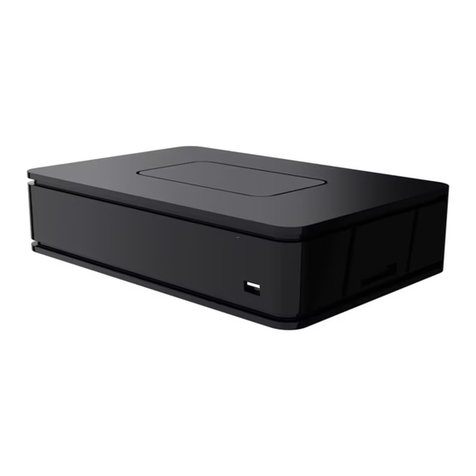
Infomir
Infomir MAG351 User manual
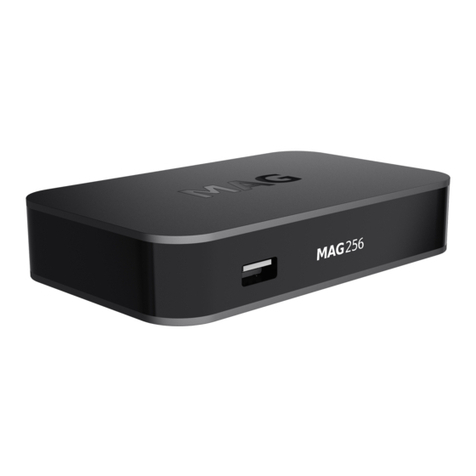
Infomir
Infomir MAG256 User manual

Infomir
Infomir MAG520 User manual
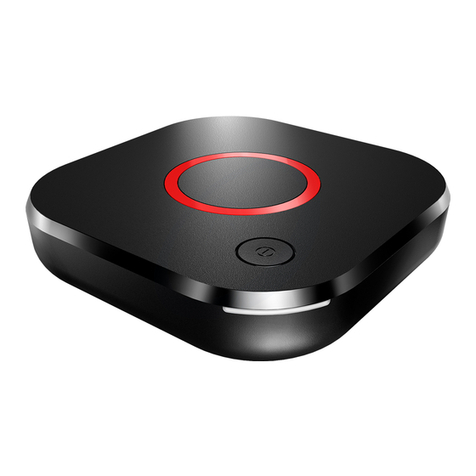
Infomir
Infomir MAG424 User manual

Infomir
Infomir MAG424w3 User manual
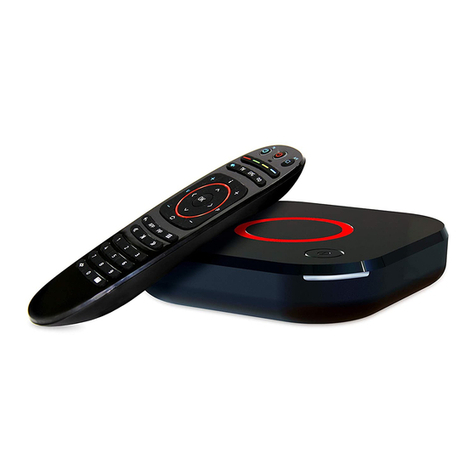
Infomir
Infomir MAG324 User manual

Infomir
Infomir MAG 254 User manual

Infomir
Infomir MAG-00 User manual
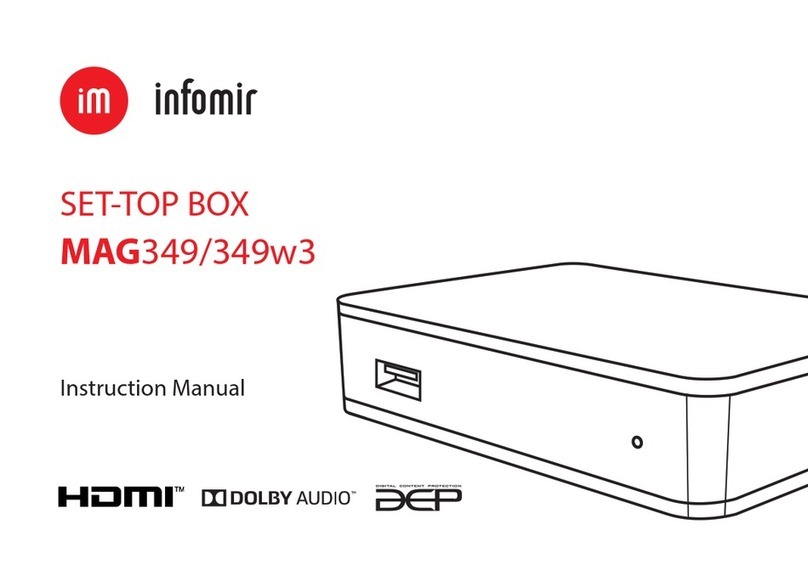
Infomir
Infomir MAG349 User manual
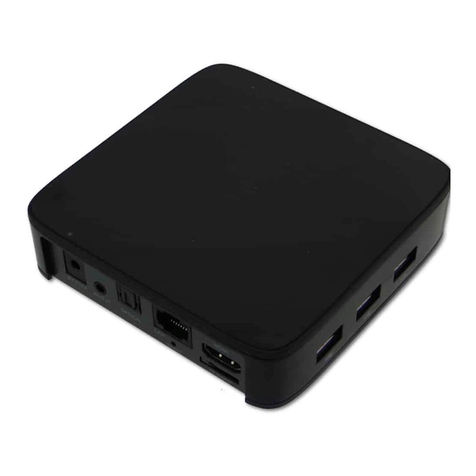
Infomir
Infomir MAG410 User manual


